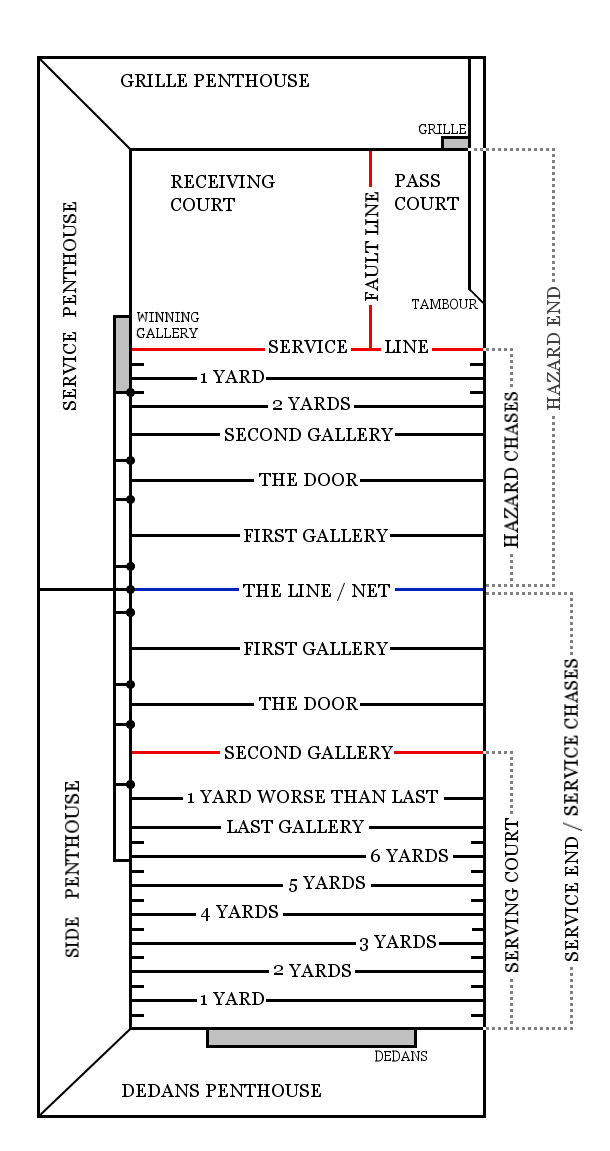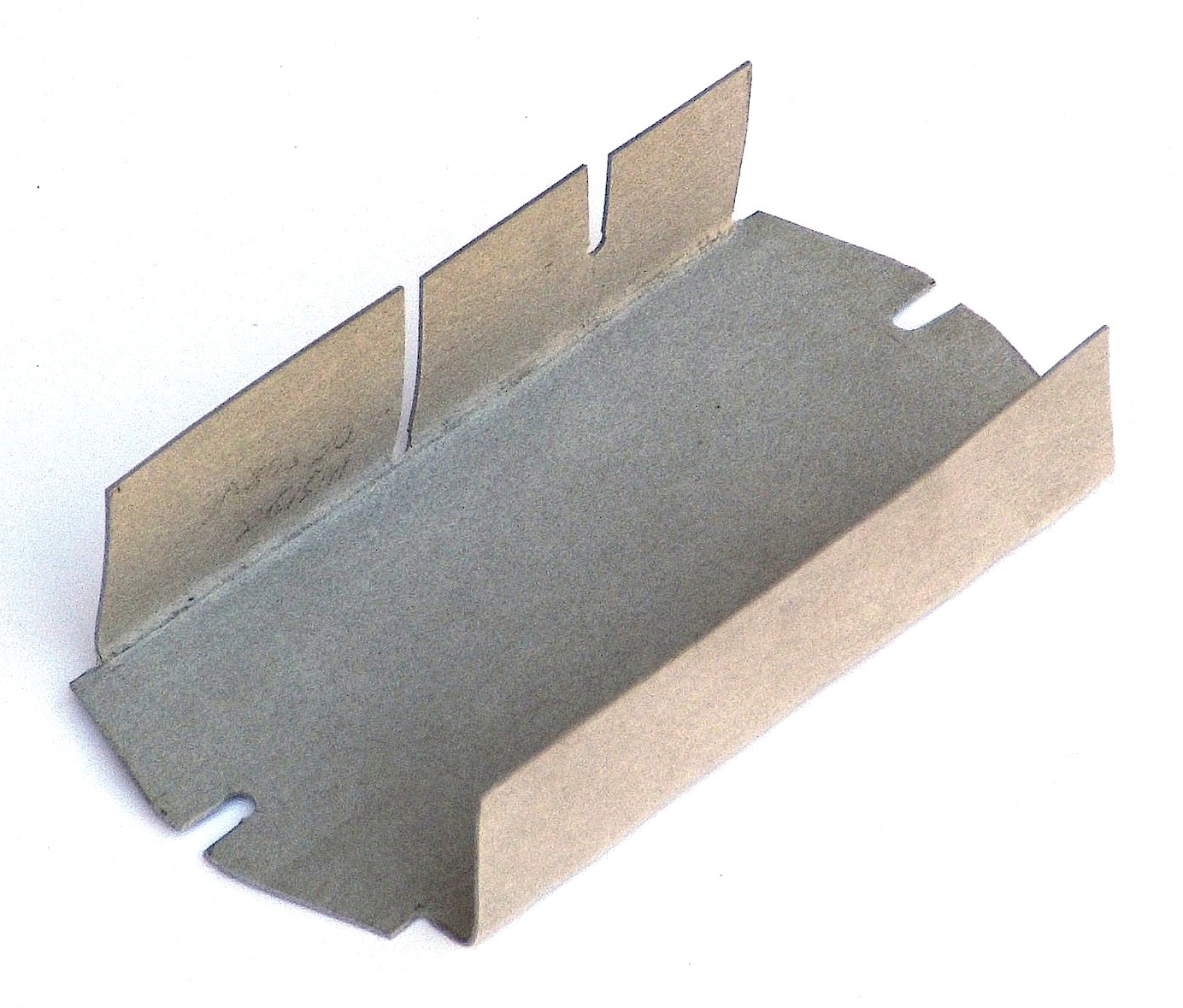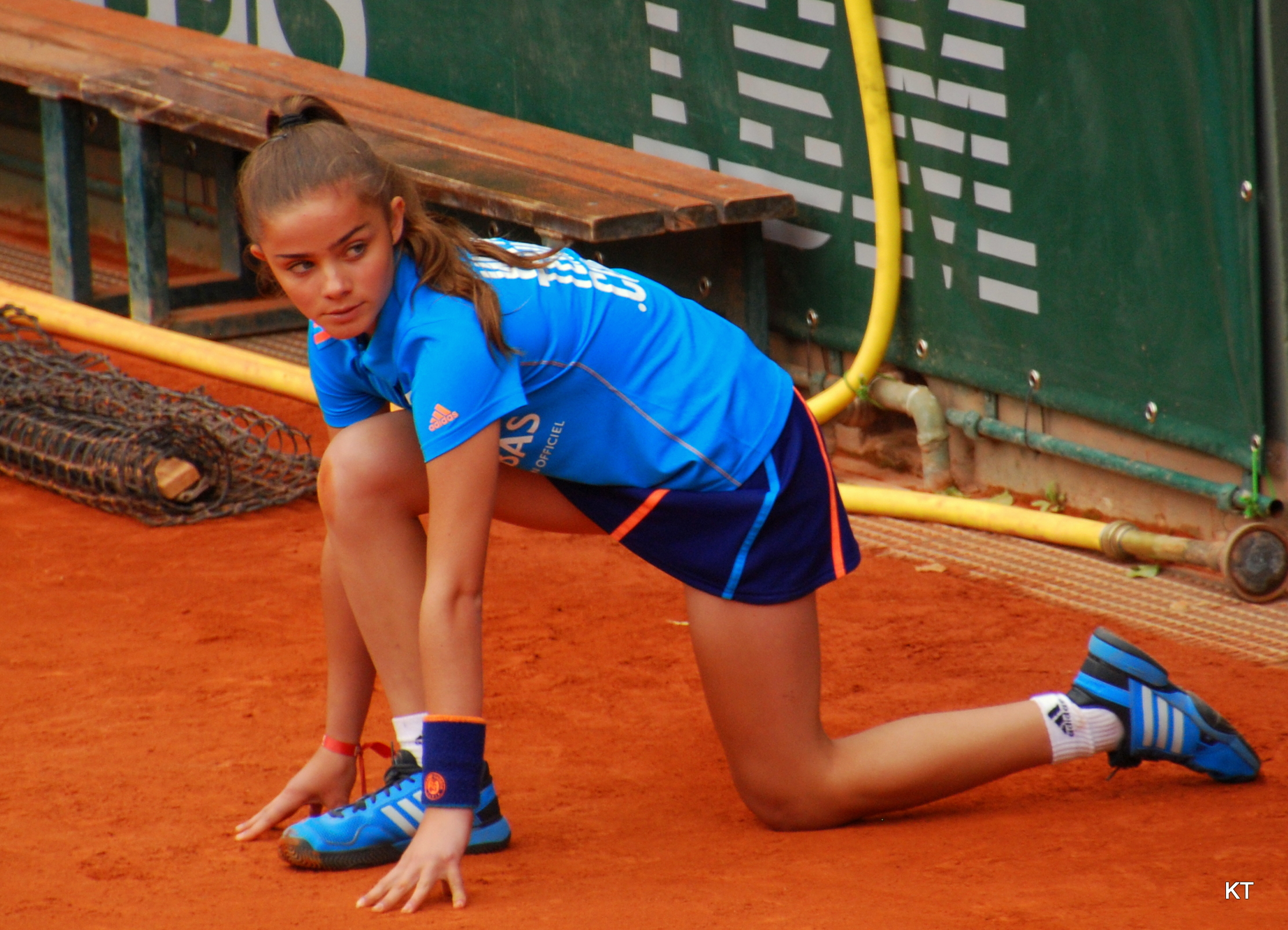|
Real Tennis
Real tennis – one of several games sometimes called "the sport of kings" – is the original racquet sport from which the modern game of tennis (also called "lawn tennis") is derived. It is also known as court tennis in the United States, royal tennis in England and Australia, and ''courte-paume'' in France (to distinguish it from longue-paume, and in reference to the older, racquetless game of '' jeu de paume'', the ancestor of modern handball and racquet games). Many French real tennis courts are at ''jeu de paume'' clubs. The term ''real'' was first used by journalists in the early 20th century as a retronym to distinguish the ancient game from modern ''lawn'' tennis (even though, at present, the latter sport is seldom contested on lawns outside the few social-club-managed estates such as Wimbledon). There are just 45 active real tennis courts in the world, located in the United Kingdom, Australia, the United States and France. There are also currently six disu ... [...More Info...] [...Related Items...] OR: [Wikipedia] [Google] [Baidu] |
Dunlop Sport
Dunlop Sport is a British sports equipment manufacturing company established in 1910 that focuses on racket (sports equipment), racquets and water sports, more specifically tennis, swimming, squash (sport), squash, padel (sport), padel and badminton. Products by Dunlop Sport include racquets, strings, tennis ball, balls, shuttlecocks, and bags. Sportswear and clothing line includes t-shirts, shorts, skirts, jackets, pants, socks, caps, sneakers, and wristbands. Dunlop Sport is operated by SRI Sports, a subsidiary of Japanese conglomerate Sumitomo Rubber Industries, which acquired the Dunlop brand in 2017. In the past, Dunlop also manufactured golf equipment. History Dunlop Rubber, Dunlop was established as a company manufacturing goods from rubber in 1889. The company entered the sporting goods market in 1910, when it began to manufacture rubber golf balls at its base in Birmingham. The company introduced the Maxfli golf ball in 1922. Dunlop extended into tennis ball manuf ... [...More Info...] [...Related Items...] OR: [Wikipedia] [Google] [Baidu] |
Strings (tennis)
In tennis, the strings are the part of a tennis racquet which make contact with the ball. The strings form a woven network inside the head (or "hoop") of the racquet. Strings have been made with a variety of materials and possess varying properties that have been measured, such as dynamic stiffness, tension retention, thickness (gauge), string texture (shape of the string), and rebound efficiency. Composition The material used in tennis string can significantly affect a player's performance, and even health. Several materials are used to make tennis strings. They vary in terms of elasticity, durability, rebound efficiency, tension holding capability, and manufacturing cost, among other considerations. Natural gut Animal intestine is the most resilient material used to make tennis strings. It has better tension retention than any other material, and also is softer than any other material used for tennis strings. It provides the most energy return, meaning it is the most efficien ... [...More Info...] [...Related Items...] OR: [Wikipedia] [Google] [Baidu] |
Nylon
Nylon is a family of synthetic polymers characterised by amide linkages, typically connecting aliphatic or Polyamide#Classification, semi-aromatic groups. Nylons are generally brownish in color and can possess a soft texture, with some varieties exhibiting a silk-like appearance. As Thermoplastic, thermoplastics, nylons can be melt-processed into fibres, Thin film, films, and diverse shapes. The properties of nylons are often modified by blending with a variety of additives. Numerous types of nylon are available. One family, designated nylon-XY, is derived from diamines and dicarboxylic acids of carbon chain lengths X and Y, respectively. An important example is nylon-6,6 (). Another family, designated nylon-Z, is derived from amino acid, aminocarboxylic acids with carbon chain length Z. An example is nylon-[6]. Nylon polymers have extensive commercial applications, including uses in textiles and fibres (such as apparel, flooring and rubber reinforcement), molded components fo ... [...More Info...] [...Related Items...] OR: [Wikipedia] [Google] [Baidu] |
Catgut
Catgut (also known as gut) is a type of cord that is prepared from the natural fiber found in the walls of animal intestines. Catgut makers usually use sheep or goat intestines, but occasionally use the intestines of cattle, hogs, horses, mules, or donkeys. Despite the name, catgut is not made from cat intestines. Etymology The word ''catgut'' may have been an abbreviation of the word ''cattlegut''. Alternatively, it may derive by folk etymology from ''kitgut'' or ''kitstring'' — the dialectal word ''kit'', meaning fiddle, having at some point been confused with the word ''kit'' for a young cat, the word "kit" being possibly derived from Welsh. In the 16th century a ''kit'' was a "small fiddle used by dancing teachers," a name probably derived from a shortening of Old English ''cythere'', from Latin , from Greek (see guitar). Common uses Musical instruments Historically, catgut was the most common material for the strings of harps, lutes, violins, violas, cellos, ... [...More Info...] [...Related Items...] OR: [Wikipedia] [Google] [Baidu] |
Willow
Willows, also called sallows and osiers, of the genus ''Salix'', comprise around 350 species (plus numerous hybrids) of typically deciduous trees and shrubs, found primarily on moist soils in cold and temperate regions. Most species are known as willow, but some narrow-leaved shrub species are called osier, and some broader-leaved species are referred to as sallow (from Old English ''sealh'', related to the Latin word ''salix'', willow). Some willows (particularly arctic and alpine species) are low-growing or creeping shrubs; for example, the dwarf willow (''Salix herbacea'') rarely exceeds in height, though it spreads widely across the ground. Description Willows all have abundant watery bark sap, which is heavily charged with salicin, soft, usually pliant, tough wood, slender branches, and large, fibrous, often stoloniferous roots. The roots are remarkable for their toughness, size, and tenacity to live, and roots readily sprout from aerial parts of the plant. Lea ... [...More Info...] [...Related Items...] OR: [Wikipedia] [Google] [Baidu] |
Vulcanized Fibre
Vulcanized fibre, also known as red fibre, is a laminated plastic composed of only cellulose. This material is a tough, resilient, hornlike material that is lighter than aluminium, tougher than leather, and stiffer than most thermoplastics. The newer wood-laminating grade of vulcanized fibre is used to strengthen wood laminations used in skis, skateboards, support beams and as a sub-laminate under thin wood veneers. A product very similar to vulcanized fibre is leatheroid; however, Leatheroid is made using a different chemical process. Since 2004, the scientific community has regained interest in this material due to its renewability and excellent physical properties, giving birth to the field of all-cellulose composites. These composites are all made of a matrix consisting of dissolved or partially dissolved cellulose, and the reinforcement remains cellulose fibres. A variety of solvents other than zinc chloride has been explored, including sodium hydroxide at low temperatures a ... [...More Info...] [...Related Items...] OR: [Wikipedia] [Google] [Baidu] |
Hickory
Hickory is a common name for trees composing the genus ''Carya'', which includes 19 species accepted by ''Plants of the World Online''. Seven species are native to southeast Asia in China, Indochina, and northeastern India (Assam), and twelve are native to North America. A number of hickory species are used for their edible nuts or for their wood. Etymology The name "hickory" derives from a Native American languages, Native American word in an Algonquian languages, Algonquian language (perhaps Powhatan language, Powhatan). It is a shortening of ''pockerchicory'', ''pocohicora'', or a similar word, which may be the name for the hickory tree's nut, or may be a plant milk, milky drink made from such nuts. The genus name ''Carya'' is , ''káryon'', meaning "nut (fruit), nut". Description Hickories are temperate forest, temperate to tropical and subtropical moist broadleaf forests, subtropical forest trees with pinnation, pinnately compound leaves and large nut (fruit), nuts. Most ... [...More Info...] [...Related Items...] OR: [Wikipedia] [Google] [Baidu] |
Fraxinus
''Fraxinus'' (), commonly called ash, is a genus of plants in the olive and lilac family, Oleaceae, and comprises 45–65 species of usually medium-to-large trees, most of which are deciduous trees, although some Subtropics, subtropical species are evergreen trees. The genus is widespread throughout much of Europe, Asia, and North America. The leaves are opposite leaves, opposite (rarely in Whorl (botany), whorls of three), and mostly pinnate, pinnately compound, though simple in a few species. The seeds, popularly known as "keys" or "helicopter seeds", are a type of fruit known as a samara (fruit), samara. Some ''Fraxinus'' species are Dioecy, dioecious, having male and female flowers on separate plants but sex in ash is expressed as a continuum between male and female individuals, dominated by unisexual trees. With age, ash may change their sexual function from predominantly male and hermaphrodite towards femaleness; if grown as an ornamental and both sexes are present, ashes ... [...More Info...] [...Related Items...] OR: [Wikipedia] [Google] [Baidu] |
Sweet Spot (sports)
The sweet spot is a place where a combination of factors results in a maximum response for a given amount of effort. In tennis, squash, racquetball, baseball, cricket or golf a given swing will result in a more powerful hit if the ball strikes the racket, bat or club on the latter's sweet spot. The sweet spot is the location at which the object being struck, usually a ball, absorbs the maximum amount of the available forward momentum and rebounds away from the racket, bat, club, etc. with a greater velocity than if struck at any other point on the racket, bat or club. In endurance sports such as cycling, sweet spot training aims to maximise training benefit — generally for performance at or near functional threshold power (FTP) — by optimally balancing training effect, physiological strain and maximum duration. Baseball A batted ball with a launch angle between 8 and 32 degrees is quantified as having been hit off the sweet spot of the bat. Balls hit in the sweet spot ... [...More Info...] [...Related Items...] OR: [Wikipedia] [Google] [Baidu] |
Racquet
A racket or racquet is an item of sporting equipment used to strike a ball or shuttlecock in a variety of sports. A racket consists of three major components: a widened distal end known as the ''head'', an elongated handle known as the ''grip'', and a reinforced connection between the head and handle known as the ''throat'' or ''heart''. The head of the racket forms a flattened firm surface, known as the ''face'', which is used to strike the ball or shuttlecock. In the strictest sense, the word "racket" specifically refers to a striking implement with a mesh face made of interlaced, tightly stretched string (structure), strings fixed on an ovoid frame known as the ''rim''. This type of racket is used in sports such as tennis, badminton, and racquetball. Some rackets have a rigid one-piece head with a solid or fenestrated face instead of a meshwork of strings. Such rackets are called a paddle or bat, and are used in sports such as table tennis, pickleball and padel. Collectively ... [...More Info...] [...Related Items...] OR: [Wikipedia] [Google] [Baidu] |
Ball Boys
Ball boys and ball girls, also known as ball kids, are individuals, usually human youths, but sometimes dogs, who retrieve and supply balls for players or officials in sports such as association football, American football, bandy, cricket, tennis, baseball and basketball. Though non-essential, their activities help to speed up play by reducing the amount of inactive time. Tennis Due to the nature of the sport, quick retrieval of loose balls and delivery of the game balls to the servers are necessary for quick play in tennis. In professional tournaments, every court will have a trained squad of ball boys/girls with positionings and movements designed for maximum efficiency, while also not interfering with active play. As well as dealing with the game balls, ball boys/girls may also provide the players with other assistance, such as the delivery of towels and drinks. [...More Info...] [...Related Items...] OR: [Wikipedia] [Google] [Baidu] |








